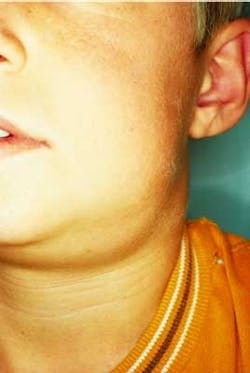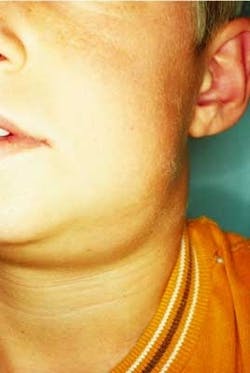Case Study
History
The patient's parent claimed that the lymph node swelling had been present for approximately 10 days. The involved submandibular area was described as tender and painful to the touch. When questioned about previous illness, the parent stated that the child had flu-like symptoms within the past two weeks. No history of injury to the area was reported. The patient had a previous history of regular and routine dental care. No significant problems were noted during the medical history.
Examinations
Physical examination of the head and neck region revealed numerous enlarged and tender submandibular lymph nodes on the patient's left side (see photo). The patient's vital signs were all found to be within normal limits. Extraoral findings included a large, red, nonpainful papule on the skin of the patient's forehead. Intraoral examination revealed no lesions present. The clinical and radiographic examinations of the teeth revealed no tooth problems or odontogenic infections present.
Clinical diagnosis
Based on the clinical information presented, which one of the following is the most likely clinical diagnosis?
- mumps (epidemic parotitis)
- actinomycosis
- nonspecific lymphadenitis
- cat-scratch disease
- infectious mononucleosis
- cat-scratch disease
Discussion
Cat-scratch disease (CSD) is an infectious disease that results from a scratch or bite of a cat. This disease begins in the skin and then spreads to the adjacent lymph nodes. While CSD has been recognized since 1931, it was only in 1994 that the actual cause was identified. CSD is caused by the bacteria Bartonella henselae.
Bartonella henselae is found throughout the world and is carried by cats and kittens. It is believed that felines are infected with this bacteria as the result of flea bites. CSD is spread to humans by a bite or scratch from a cat, most often a kitten. The kitten or cat that spreads the infection is not sick, and this infection is not spread from person to person. The Cen ters for Disease Control (CDC) estimates that 24,000 people seek medical care and 2,000 are hos pi t alized each year be cause of CSD. While CSD is not a severe illness in people who are healthy, it can be debilitating in individuals with compromised immune systems.
Clinical features
Although anyone can get CSD, most cases occur in individuals under the age of 21. People who own or handle cats are at an increased risk. The bacteria that causes CSD enters the skin through a scratch or bite. A papule, usually less than 5 mm in diameter, develops on the skin in the area of injury within two weeks. The papule is brownish-red in color and nonpainful. The lesion may last for a period of days or weeks. Other symptoms may include fever, malaise, headache, fatigue, and loss of appetite. Such symptoms may last for weeks or months. Most patients do not present with constitutional symptoms.
Within two to three weeks, the lymph nodes near the area of the original scratch or bite enlarge and become swollen and tender. The lymph nodes may swell to an inch or more in size. Lymph-node groups most often involved include the axillary, cervical, submandibular, and preauricular. The duration of enlargement is four to six weeks, with possible persistence up to 12 months. Over time, the nodes return slowly to their normal size. In children, CSD is the most common cause of prolonged lymph-node swelling in a localized area. Because a cat scratch to the face results in submandibular lymphadenopathy, a patient may be referred to a dentist to rule out odontogenic infections.
Diagnosis and treatment
CSD can be diagnosed on a clinical basis if a positive history of a cat bite or cat scratch is obtained along with the presentation of swollen, painful lymph nodes. If the diagnosis is unclear, a skin test, a blood test, or a lymph-node biopsy can be used to confirm the diagnosis.
CSD is a self-liming disease and normally resolves within one to four months. Antibiotics are not effective in immunocompetent individuals. Management includes symptomatic care, such as use of local heat on swollen lymph nodes and analgesics for pain. Lymph nodes that contain pus may need to be drained. All patients should be observed for complications, such as encephalopathy and neuroretinitis.
Joen Iannucci Haring, DDS, MS, is an associate professor of clinical dentistry, Section of Primary Care, The Ohio State University College of Dentistry.

